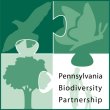|
 PBP Home
PBP Home
 What Is Biodiversity?
What Is Biodiversity?
 Economic Impacts
Economic Impacts
|
 |
Pennsylvania
Biodiversity Partnership
What
Is Biodiversity |
| |
| What
is Biodiversity? |
| Biodiversity
is the variety of species, their genetic make-up, and the natural
communities in which they occur. It includes all of the native plants
and animals in Pennsylvania and the processes that sustain life
on Earth. Pennsylvania is home to over 25,000 different species
of organisms, and of this total, over 800 are considered to be rare,
threatened, or endangered. For many groups of organisms, such as
insects, fungi, and algae, very little is known about them - not
even what species occur in Pennsylvania! The need to understand
the state's rich natural resources has never been more critical. |
| |
| The
term ecosystem is defined as a community of living organisms combined
with their associated physical environment. It is our "home
system" that makes life possible. Ecosystems are the full tapestry
of nature that support life and they also provide valuable services. |
| |
| • |
Wetland
ecosystems filter out toxins, clean the water, and control floods. |
| • |
Estuaries
act as marine-life nurseries. |
| • |
Forest
ecosystems supply fresh water, provide oxygen, control erosion,
and remove carbon from the atmosphere. |
| |
| Many
species, working together, are needed to provide these critical
services. The loss of biodiversity reduces nature's ability to perform
these functions. As greater fluctuations occur, ecosystems as a
whole become less stable. Instability causes ecosystems to be more
vulnerable to extreme conditions and may also decrease productivity. |
| |
| Why
is Biodiversity Important? |
| While the term "biodiversity"
may not be well known or understood,
the ecological services provided by biodiversity are vital to everyday
life. Not a day, hour, or even second goes by that we do not depend
on biodiversity for survival. |
| |
| • |
The
air we breathe is a product of photosynthesis by green plants. |
| • |
Insects, worms,
bacteria,and other tiny organisms break down wastes and aid in the decomposition of dead plants and animals to
enrich soils. |
| • |
More than 90 percent
of the calories consumed by people worldwide are produced from 80 plant species. |
| • |
Almost 30 percent
of medicines are developed from plants and animals,
and many more are derived from these sources. |
| |
|